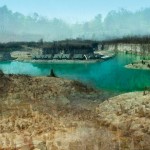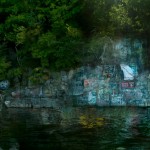The Pits:
Empire Falling: New Photographs by Elena Dorfman
Phyllis Weston Gallery, March 29-May 11
By Jonathan Kamholtz
From a distance, “Empire Falling #6” (the artist’s titles are not very helpful as aide-memoires or to help us focus on the picture’s issues) might be a colorized photograph taken by a long-gone intrepid nineteenth century archeological explorer. The landscape is desolate, remote, and unpeopled. A low horizon line makes it look like Big Sky country, only in Upper Egypt, Afghanistan, or Peru. Having survived a rigorous ascent, we would have made our way through the gap between two rugged bluffs to find…a tennis court, with a maintenance shed and well trimmed shrubberies peppered around a cyclone fence. The court is bright, astroturf green. Elena Dorfman’s photographs—or more properly, her meticulously edited digital photocollages—explore an American ambivalence about nature as long-standing as our recorded history: seeking nature, we end up remaking it. We reshape it physically, and reimagine it in our images of it.
The show at the Phyllis Weston Gallery, curated by Morgan Cobb, draws from the book of Dorfman’s newest work, Empire Falling, published in 2012 by Damiani/Crump. Stunningly printed on bright, metallic paper, the photographs record Dorfman’s views of the changing intersections between landscape and industry. Drawn initially to quarries in Ohio, Kentucky, and Indiana so she could work with the culture of quarry divers (remember Breaking Away?), she found herself instead working with the sequential repurposing of the heartland. She writes: “What began as a sociological exploration of the communities that gather at quarries to jump from rocky precipices into water, evolved into a study of these massive pits, often overlooked and unseen.” In the nineteenth and early twentieth centuries, the land was cracked open for the high quality limestone that built private and public projects such as Rockefeller Center, the Empire State Building, Louisville’s Seelbach Hotel and Speed Museum, the entranceway to Cincinnati’s Belvedere Apartments, and the columns in front of UC’s Tangeman University Center. There is a genre in late nineteenth/early twentieth century photography that celebrated the craftsmanship and brute mechanical strength needed to remove all that stone. People were fascinated by both human determination and nature’s monumentality, and produced and consumed images showing how the great flat spaces of the Midwest were contributing to the verticality of America’s growing cities.
This is not what Dorfman is after. Her quarries are ghost towns, part of the rust belt’s great decline. In place of industry, there are relics of the past and empty space. In #3, for example, there are some scattered signs of quarry machinery, but far below them we see vast ghostly stone staircases leading up to the sheer face of the rock walls. In #13, the vertical walls are speckled with wooden ladders, like you might see at Anasazi ruins. The tracings of a past is the only life we can see in some of the images.
The photographs are marked by lyric melancholy over the things that have been lost, but also a critical engagement with the nature of that loss. In place of the ingenuity that muscled huge stones into buildings, Dorfman has found and focused on the ingenuity that can make new use of the flooded interiors and steep walls of the quarries. A new generation recolonizes nature for recreational purposes and gets domestic satisfaction from living on the edge. The geological layering of the quarries and the almost archeological layering of man’s excavations are often in thoughtful, powerful, and even wondrous harmony with the layering of the elements of pictures that Dorfman’s photographs have assembled.
In Empire Falling #8 an arc of a half dozen or so McMansions sit on a peninsula at the edge of a turquoise body of water that has flooded a quarry whose walls can be seen in the distance, but which also crowd in a short space behind the houses. In the foreground, just across the water, is a field of brown, squared-off, unharvested stones. Heavy construction equipment is tucked discreetly in the background: there’s going to be more buildings, wider roads, swimming pools—who knows what. On the gallery wall is a quotation from Dorfman’s book: “As globalization and consolidation continue unchecked, these astonishing landscapes are transfigured—with landfills, golf courses, and exclusive housing communities—wherein the quarry element has, ironically, been incorporated into the development as a scenic or recreational point of focus.” The layering adds its own levels of magic. While there is a clear horizon line at the peak of the quarry, there are ghostly intimations of another—and perhaps more than one—horizon of trees and forests enclosing the built-up spaces. And deep beneath the turquoise waters are hints of other structures. A Lost City?
Our responses to an image like this are likely to be layered as well. Perhaps the ghostly landscape is a reminder of a natural beauty that stubbornly refuses to be bulldozed. Or perhaps the transparent slivers of woods serve as an elegy to the beauty that was sacrificed to allow the rocks to come out in the first place, and then to allow the houses to come in later. Or perhaps nature is edging its way towards what humans have built, waiting to return, to reassume its dominance. And the underwater structures could be a tribute to the things built from the removed stones or, as in the fantastic haunted worlds of some gothic novel, they could be lurking, haunting, and sinister. What seems clear is that our taming of the landscape is a complex story.
The photographs raise questions of ownership, of taking title. The houses in this photograph sit overlooking a field of victory, like a shopping center built on the edge of Gettysburg. They are like guardhouses keeping a conquered territory in check, though the complex layering of added elements suggests that there is a vanity and a futility to their stolidity. This suggests the aptness of Dorfman’s title. We approach our own land with an urge to colonize. And after the work of empire comes its play, and the need for the comfortable, the familiar, and the incongruous.
In Empire Falling #1, a latticed metal tower poking through the clouds sits at the peak of a quarry wall, six cables radiating from its top. Scanning down, we find a beautiful band of flowering dogwood. At the foot of the walls, the water is dark, still, and uninviting. It is hard not to think of Aztec cruelty and human sacrifice, updated perhaps to the appetites of industrial capitalism. Is the tower a look out for guards, a conduit of electricity, or an old ski lift? To talk about this makes me feel like I’m on the island in Lost. There is a lyric grandiosity to what humans have brought to this place, though it seems a memorial to irretrievable function.
But the show is not bleak or preachy or devoid of the human trace. Empire Falling #21 (at 98” by 44”, it is so large that the gallery’s publicity materials refer to it as “the mural”) shows the long wall of a quarry from the waterline below to the edge of the woods above, from which a barely visible diver at the upper left is preparing to jump. Each stone is covered with brightly painted graffiti that cumulatively articulate the various ways that life energies are brought to quarries—and perhaps the whole rust belt–nowadays. One stone reads “Trux/Dirty/Ike” and then “Coal Makes Power.” One stone has the Playboy logo; another has a painted trombone. One reads “Not here for a long time here for a good time,” while another reads “Keep Calm and Chive On.” One bears a note left by the “drunk team” and more than one pays homage to “Bud,” which, judging by this wall, would probably not make a bad investment. (In Falling Empire #4, a similar but more intimately scaled photograph, a young woman is poised to take the plunge into the water from a rock; her canoe floats serenely nearby with a large cooler at the bow.) One stone is labeled “Rumpke Mountain Boys.org,” a truly great name for a Midwest country band. A quarry is a place with a strong sense of absent presences. Once there was stone there and now there is a huge empty space. Once there were taggers crawling over these rocks, but now, having left their various announcements, they are gone, and the waters are silent and the growth of the forest may even be poised to reach down and reassert its dominance.
It partly enriches and partly complicates this show that the huge wall, with every stone painted, doesn’t actually exist in the world. The graffiti on the rock wall was put together by Dorfman out of more than 300 individual photographs, very expertly cut and pasted. Indeed, it’s not entirely clear whether the wall, as we see it, exists at all. The haunting and miraculous shapes and structures we can make out in the depths of the water in several of the pictures surely aren’t there. What about the row of houses by the water’s edge? And what about the tennis court?
Like a great many contemporary photographers, Dorfman offers us images of scenes that are at least partly “real,” but in a non-journalistic way. For her previous project, Still Lovers, she took life-sized female sex dolls, dressed them up in clothes and wigs, and posed them with men, families, pets, and each other. The pictures are funny, deliberately creepy, and several other things as well, and are surely designed to raise questions precisely about the value we place on what is “real.” Empire Falling presents the work of an artist who is engaged in creative conversation with what is actually there rather than one presenting documentary work. And it’s certainly true that the documentary mode is fraught with its own sets of fictions. But if the logic of empire is that one’s own set of values get imposed upon the raw material of geography, there is at least a bit of imperial logic that Dorfman herself has used in assembling these lush and critically aware landscapes. I caught myself wondering exactly who it is who could not imagine life near the quarry without the familiar and soothing comfort of a tennis court or a swimming pool—who, if anyone. In her strategic decision to obscure the documentary roots of the finished images, the artist sometimes seems to be critical of the transformation of the quarry landscape, but doing so using the passive voice.
America is a strong place to look for signs of what Dorfman calls “the evolving earth.” Though less brutal these days than, say, what is happening in contemporary China, America offers ample evidence of the restless transformation of landscape. And sometimes we’ve gotten good value: think of the T.V.A. Dorfman’s pictures of the repurposing of the land into quarries and the repurposing of the quarries into something else leave us with the feeling that part of what has been lost is a sense of a grand cultural project. In the examples on display from Empire Falling, we dig holes, and then we walk away from them. Then we come back to sign our names. But Dorfman also suggests that the mystery remains, something untamable in the ruins of lost cultural function, in the unplumbed depth of the water, and in the lurking sense that nature is waiting and able to reclaim its dominion.
- Elena Dorfman
- Elena Dorfman
- Elena Dorfman
- Elena Dorfman “Empire Falling #21”











